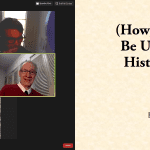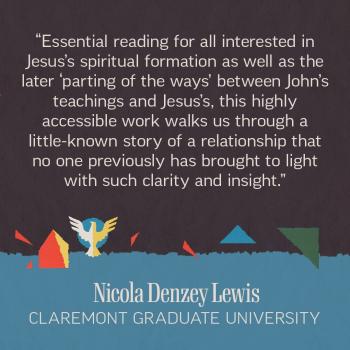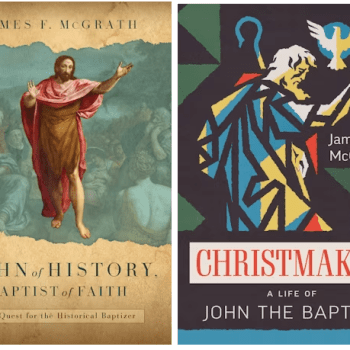Yesterday was the first day of the Enoch Seminar Nangeroni Meeting conference taking place online this week, focused on John the Baptist. I’ve obviously been incredibly excited about this event, since I am working on a major book about John the Baptist.
Gabriele Boccaccini started things off with an overview of the reception history of John the Baptist, including literature and film as well as scholarship. In the process he highlighted the incredible wealth of information on this subject available in the 4Enoch online encyclopedia. Some that I thought were particularly noteworthy were the existence of a mosque with relics dedicated to John the Baptist in Sebaste, Samaria; the history of visual art and painting; the lack of focus on him as a figure in fiction prior to Brooks Hansen’s novel; and the first musical treatment in 1675 in an oratorio by Stradella. John appears regularly in films about Jesus, yet he is the only significant biblical character to whom not a single movie has been dedicated. He is overshadowed in the New Testament and even today. Salome is given focused attention yet John is not. Boccaccini also highlighted the importance of Kohler’s article in the 1901 Jewish Encyclopedia in which he emphasized that John was a Jew not a Christian, and included discussion of the Essenes and also the Mandaeans.
This was followed by the Freedman Panel. Joel Marcus started things off. He made an analogy with Tom Wicker’s article “Kennedy Without Tears” which attempted to study and remind what John F. Kennedy was like before and behind the hagiography. In the case of John the Baptist it is likewise the case that the man has faded behind the myth and monument. The Gospels obscure the reality in the interest of a revisionist account, especially in John’s Gospel, aimed at polemicizing against an ongoing group of followers of John that remained focused on him. He embraces the competition hypothesis, i.e. that the movements around John and Jesus were competing with one another.
Joan Taylor presented next. She shared that she began her work expecting to focus on Jesus, and how spending time living in Africa drew her attention to John the Baptist. There she saw a man in a trance leading a noisy crowd of followers who were in a state of celebration. This made her think of John the Baptist, who was believed to have experienced a revelation and gathered a band of follower. This in turn led her to realize how little historians have not only about John but about the context of first-century Judaea. That fact, combined with our choice of what to focus on and prioritize, has shaped our impression. She is persuaded that John was influenced by Isaiah’s message about the exclusion of the unclean from Jerusalem and the need to repent and act justly. Josephus conveys an accurate impression of John when it comes to these emphases. John didn’t need to explain this since his hearers were familiar with Isaiah.
Edmondo Lupieri followed and likewise shared his story of how he ended up focusing his research on John the Baptist. There is an incredible history of influence and reception of John the Baptist, including in places you might not expect, such as the diaries of Joseph Goebbels. Lupieri’s primary interest was in John the Baptist in Gnosticism, especially Mandaeism. He is convinced that elements that are mentioned in passing, such as his clothing and family background, are important because they may be less likely to be purely Christian inventions. We have made of John what we pleased, but even so the at times polarized interaction between them comes through.
Next was Rivka Nir, who explained that her John the Baptist is a Christian one, the only one (in her opinion) that is visible in the sources. In Judaism repentance is focused on God. For John, on the other hand, an alternative means of atonement is offered. You can read my review of her book on John the Baptist in Reviews of the Enoch Seminar.
Albert Baumgarten situated John in relation to common Judaism as well as in the context of his competition with Jesus. He points out how puzzling John’s baptism is for a variety of reasons. Baumgarten emphasized the statements in the Mishnah that require immersion even if one had done so previously before entering the temple’s sacred space. Jubilees 21:16 confirms the antiquity of this stance. This applied to priests, but was extended to all. Baumgarten thus sees John as getting the people ready for an encounter with God. The identification of Jesus as John raised from the dead, attributed to prince Herod in the Gospels, makes Jesus subordinate to John.
Gabriele Boccaccini then returned to conclude the session. He views John as standing in the tradition of Enochic Judaism. He expected a greater one, an angelic figure who is also the anointed one, the Son of Man of the Parables of Enoch. A time of judgment and forgiveness was coming, a “baptism of fire.” In his view, John took this widely held expectation and proclaimed that it was about to come to pass. He was not an Essene, and did not proclaim himself to be the messiah. John’s difference from the Book of Jubilees is that John did not think Jews had been preserved and protected from the influence of evil. Jesus was one of the many sinners who heard the message of John and came to him to be baptized. He subsequently proclaimed precisely the same message as John, at least initially. It was not the expectation that everyone would be baptized, but that sinners would do so in repentance. The death of Jesus led to significant reinterpretation of both John and Jesus on the part of Jesus’ followers. It is time for John’s importance in first century Judaism to be rediscovered, not overshadowed by his most famous disciple, Jesus.
The afternoon session moved into more of a workshop mode, digging into details. Steve Mason started things off, focusing on Josephus’ portrait of “John the Drencher.” Even in this introductory remark, Mason highlighted the role of language in conveying an impression of what someone is trying to say, and how use of familiar language such as in referring to John the Baptist brings in assumptions that Josephus’ readers would not have had. Josephus aimed to interpret John in relation to Greco-Roman ideas of good men and justice, which they often contrasted with the superstitious washings of other peoples. It is likely that John was executed in Galilee where Herod was holding his party, and not in the middle of the desert.
Johannes Tromp argued that John was executed later than Jesus, and that his proclamation was that which also characterized Jesus, perhaps without the messianic elements. He views the relationship between the movements around the two was much more friendly and less antagonistic than other presenters have proposed. In the Life of Adam and Eve the tomb of Adam is sealed. Sealing is a term that is sometimes used to refer to baptism. Adam is said to have been washed by an angel three times (cp. the Apocalypse of Peter and the Apocalypse of Paul).
Kelley Coblentz Bautch focused on John and Elijah in light of a more detailed look at the latter, not only in the story in the Hebrew Bible, but in subsequent Jewish tradition and literature. To give one example, Ben Sira 48:10 talks of Elijah’s eschatological role. The Dead Sea Scrolls also explore the figure of Elijah in greater detail. Stories that go into speculative detail about baby Elijah include elements that resonate with the way other figures are depicted in Jewish and Christian literature. When we consider the debate over whether John or Jesus was Elijah, and whether Jesus was John, we see a neglected aspect of this subject, namely in what sense one figure could be considered to be another. How does this relate to phenomena such as pseudepigraphy, and to the depiction in some Enochic literature of Enoch being identified with the Son of Man? I was particularly happy to hear the presentation highlight this, since it is one of the areas that my book will explore.
Daniele Minisini looked at whether John is accurately characterized as an apocalyptic figure, and if so what that means. He focused on the Parables of Enoch, which includes a high degree of agrarian imagery, which ties in with the imagery of the threshing floor attributed to John in the Gospels. In the discussion after the session Claude Cohen-Matlofsky offered a response to and interacted with a number of points made by others in the session. For example, she argued against Nir that Josephus does indeed distinguish between different kinds of immersions. She asked why Josephus would have chosen John’s virtues to highlight the wickedness of Herod Antipas. She also made a case for more study of the figure of Banus with whom Josephus says he studies, given that Banus is not a name known from Roman Palestine, and his similarities to John the Baptist. Kenneth Atkinson noted the non-apocalyptic depiction of John by Josephus. Lupieri mentioned Origen’s discussion of the “spirit” of Elijah coming to dwell on/in Elisha, which seems relevant to the topic that Koblentz Bautch brought up. Lupieri asked whether Banus offered any apocalyptic teaching akin to that of John and Jesus. Larry Schiffman emphasized how much is being built on a foundation of very minimal evidence. Replying to a question from Joel Marcus, Kelley Coblentz Bautch mentioned the work of Charles Stang and others on divine Doppelgangers as a possible direction for future research about John and Jesus as (and not merely as like) Elijah or other figures. I will just say I have a proposal related to that that I look forward to spending time researching in the coming years. Daniele Minisini is skeptical of the idea that John was against the temple, suggesting that likely derives from a hermeneutic that thinks in terms of contrasts between Jesus and those aligned with him and Jewish institutions and worship. Steve Mason suggested that Jesus was a fan of John the Baptist, but that does not mean that John knew very much about Jesus. Boccaccini mentioned being intrigued by the lack of reference to Elijah in Enochic literature, and also the importance of Coblentz Bautch’s question about how one comes to an awareness of being another figure, as in the case of Enoch and the Son of Man in the Parables.
In the final session of the first day, Michael Daise turned our attention to the famous Isaiah quotation (40:3) associated with John. He sees evidence of the influence of that verse on discussions of righteous living which talk of people’s ways being made straight. He notes that John’s Gospel does not situate the Baptist in the wilderness, mentioning only place names without any indication of a connection with wilderness. As Joan Taylor has argued, the Synoptics probably give a misleading impression that John the Baptist was someone fixed in terms of the location of his activity. He suggests that the depiction of John as the voice of one who cries in the wilderness, as opposed to one crying in the wilderness, this may suggest that God is the one who is thought of as metaphorically crying in the wilderness, with John as his voice and representative in a wider geographic area.
Rafael Rodriguez asked about the role of memory as a constraint on how people portray the past. We cannot simply assume that our sources portray the past as it actually happened, but neither can we assume that the influence of traditions (some of them authoritative) did not constrain their freedom to be creative. In other words, he is drawing on social memory theory. Rodriguez suggests that critical historians do not always justify their claims, and that typical historical reconstructions do not address certain key matters, such as why or how precisely Christians would have sought to subordinate John to Jesus if they knew they were elevating a subordinate figure. For example, Crossan’s proposal that Jesus’ followers were seeking an apocalyptic figure like John and turned Jesus into such a figure, why would they not simply have followed John? Something about the two figures must have allowed them to be configured in relationship to one another with Jesus plausibly claimed as superior and John as a plausible forerunner. In light of this, John did predict the imminent arrival of God (his “coming one”), but he may have worded this in a way that allowed a decisive agent of God to be involved. At some point, Rodriguez argued, Jesus came to see himself as John’s coming one, so that this argument found in the Gospels originates with Jesus himself. The portrayal of John as forerunner began with Jesus, not his followers. Rodriguez also thinks John at least entertained the possibility that Jesus was his predicted “coming one.” If the Gospel authors did not take seriously the memories about these individuals, their works would not have made the impact they seem to have desired to on their audience constituted of John’s followers and others of Jesus’ followers.
Francesco Pieri spoke about what Origen has to say about John the Baptist. Origen held interesting ideas about the preexistence of souls and their movement into and out of bodies. He was also more interested in allegorical interpretation that could apply John’s story to Christian spirituality, than in getting behind the text to the historical figure.
Joan Taylor spoke about John the Baptist in early Christian art, bringing in film as well in the introduction. Mark 1:6 gives us very little to go on, although it does indicate sackcloth of a kind still used in the Middle East. Camels shed their hair annually and so is readily available and that makes this comparable to his diet which also focused on what could be found. In the Chapel of the Sacraments in St. Callixtus there is what looks like it may be a 3rd century depiction of John the Baptist. John is often depicted as more like a god (in particular Asclepius) than a philosopher, in terms of ancient artistic conventions.
In the discussion afterwards, Lupieri highlighted that we do not know where in Antipas’ territory various things may have unfolded, although there is a convergence of evidence on his imprisonment at Machaerus. With respect to art and text, we might well ask which influenced which. Rafael Rodriguez emphasized that we are not talking about objective things but perception. John the Baptist was at least at one early stage more popular than Jesus, and later Jesus was objectively more popular than John, and at times and in particular contexts there may have been ambiguity. Federico Adinolfi highlighted that Jesus said he had a baptism to undergo, which suggests that he did not see himself as the coming one, although he does seem to have understood himself as a bridge between John and the arrival of God in power. Joel Marcus asked whether the depictions of Jesus as a child when baptized by John shared by Taylor in her presentation reflect the developing practice of infant baptism or something else. Taylor suggested that there was, on the one hand, the influence of imagery connected with Dionysius, and on the other hand the idea of the Christian renewed in baptism becoming as a child. David Katzin asked Rafael Rodriguez whether Josephus’ statements about John do not indicate that John was more famous. This might reflect thinking in Judaea in the period prior to the Jewish War. Rodriguez resisted the idea, emphasizing that we have no popular polling from the first century. At most Josephus’ account may tell us about Josephus’ perspective, not about general perceptions. Joan Taylor mentioned her longstanding complaint that art historians do not know Patristics sufficiently.
I asked whether the diverse interpretations of both John and Jesus–as faithful Jews and as Gnostic revealers who opposed Torah and the creator responsible for it as well as a variety of other things–might not require us to posit that both figures were such, and interacted with diverse audiences, so as to be understood almost from the beginning in different ways? We spend most of our time trying to pin them down. In what ways were they genuinely ambiguous in their time? Might each have been more or less popular in particular regions or contexts or among particular groups? If time had permitted I would also have asked, if we view John and Jesus as teaching about as well as undergoing mystical experiences, how can historian do justice to this aspect that is inherently experiential and potentially esoteric?
The first day was already incredibly rich and rewarding. You can find some of the presentations and handouts on the Enoch Seminar webpage about the conference. That includes a draft of my presentation scheduled for tomorrow morning. See also the news about the supposed identification of the site where John the Baptist died, and Candida Moss’ commentary on it. There’s also encouraging news about the traditional site of Jesus’ baptism by John.
















